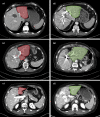Current evidence on posthepatectomy liver failure: comprehensive review
- PMID: 36415029
- PMCID: PMC9681670
- DOI: 10.1093/bjsopen/zrac142
Current evidence on posthepatectomy liver failure: comprehensive review
Abstract
Introduction: Despite important advances in many areas of hepatobiliary surgical practice during the past decades, posthepatectomy liver failure (PHLF) still represents an important clinical challenge for the hepatobiliary surgeon. The aim of this review is to present the current body of evidence regarding different aspects of PHLF.
Methods: A literature review was conducted to identify relevant articles for each topic of PHLF covered in this review. The literature search was performed using Medical Subject Heading terms on PubMed for articles on PHLF in English until May 2022.
Results: Uniform reporting on PHLF is lacking due to the use of various definitions in the literature. There is no consensus on optimal preoperative assessment before major hepatectomy to avoid PHLF, although many try to estimate future liver remnant function. Once PHLF occurs, there is still no effective treatment, except liver transplantation, where the reported experience is limited.
Discussion: Strict adherence to one definition is advised when reporting data on PHLF. The use of the International Study Group of Liver Surgery criteria of PHLF is recommended. There is still no widespread established method for future liver remnant function assessment. Liver transplantation is currently the only effective way to treat severe, intractable PHLF, but for many indications, this treatment is not available in most countries.
© The Author(s) 2022. Published by Oxford University Press on behalf of BJS Society Ltd.
Figures



References
-
- Gilg S, Sandstrom P, Rizell M, Lindell G, Ardnor B, Stromberg Cet al. . The impact of post-hepatectomy liver failure on mortality: a population-based study. Scand J Gastroenterol 2018;53:1335–1339 - PubMed
-
- Rahbari NN, Garden OJ, Padbury R, Brooke-Smith M, Crawford M, Adam Ret al. . Posthepatectomy liver failure: a definition and grading by the International Study Group Of Liver Surgery (ISGLS). Surgery 2011;149:713–724 - PubMed
-
- Michalopoulos GK, Bhushan B. Liver regeneration: biological and pathological mechanisms and implications. Nat Rev Gastroenterol Hepatol 2021;18:40–55 - PubMed
Publication types
MeSH terms
LinkOut - more resources
Full Text Sources
Miscellaneous

